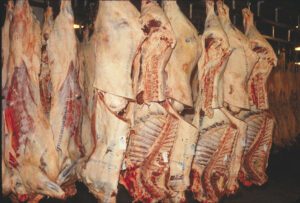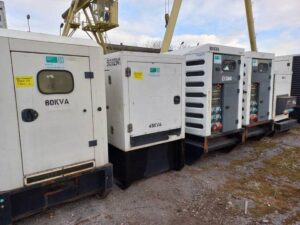
Ukraine has abandoned the March 5 ban on the export of live cattle (UKTVED code 0102), frozen cattle meat (code 0202) and meat and edible meat by-products, salted or in brine, dried or smoked; edible flour from meat or meat by-products: cattle meat (code 021020).
According to the resolution of the Cabinet of Ministers No. 422 of April 9, published on its website on Sunday night, licensing of the export of these goods was introduced instead of zero quotas.

Ukraine has received two batches of mobile power generators in a total of 177 received from the UK to maintain the reliability of the country’s energy supply, the Ministry of Energy said in a statement.
“In total, the UK announced the transfer of more than 500 portable generators, which will be used by both public and commercial energy companies to provide sustainable power to social facilities, homes, businesses,” the ministry said.
The generators will become a backup source of power in the event of a power outage as a result of enemy shelling of electrical networks and equipment.
“One of our main tasks is to provide our citizens, businesses, the Armed Forces of Ukraine with a stable energy supply. At a time when the Russian invaders are destroying our power grids and critical energy infrastructure, these generators will become an additional guarantee of a reliable energy supply for Ukrainians,” Minister of Energy German Galushchenko stressed. .
As informed in the Ministry of Energy, in the near future, deliveries of the following batches of mobile power generators from the UK are expected.

Sanctions imposed by the European Commission in response to aggression from Russia and Belarus allow these countries to continue trade with the European Union, the press service of the Ministry of Infrastructure of Ukraine reports.
The department points out that the order to leave the EU territory from April 16 for all trucks registered in Russia and Belarus contains many exceptions.
“In particular: natural gas and oil, including refined products, as well as titanium, aluminium, copper, nickel, palladium and iron ore; pharmaceutical, medical, agricultural and food products, including wheat and fertilizers; humanitarian cargo; separately provides for the possibility of making exceptions for Russian companies in the export and transfer of cultural property provided for temporary use,” the Ministry of Infrastructure comments.
The ministry called such sanctions inconsistent and reminded that due to the aggression of Russia and Belarus, not only the Ukrainian economy, but also the EU countries suffer.
“Currently, those goods that cannot be exported from Ukrainian ports will be delivered to the EU by road and rail. The costs of building new logistics routes will amount to billions … To receive these goods, EU member states must prepare their infrastructure for warehouses, customs points , the work of sanitary services,” explains MIU.
They also recalled that the introduction of the fifth package of sanctions by the European Commission took place against the backdrop of the massacres of civilian Ukrainians in Bucha and other cities, but the half-measures taken leave an opportunity for the EU to continue its usual business with the aggressor.
Infrastructure Minister Alexander Kubrakov, in turn, added that in this way the world repeats the mistakes of the twentieth century.
“I urge the world not to repeat the mistakes of the 20th century and instead of appeasing the aggressor, thinking about financial benefits, start fulfilling the promises made. This is the only way our common enemy loses,” he wrote on his Facebook page.

The number of internally displaced persons (IDPs) in Ukraine due to the war unleashed by Russia has reached 7.1 million, according to the Office of the United Nations High Commissioner for Refugees (UNHCR) on April 6, which previously estimated this figure at 6.5 -6.7 million
“More than a quarter of Ukraine’s population has been forced to leave their homes. To date, more than 4.3 million refugees have left Ukraine, making this the fastest growing refugee crisis since World War II,” the report on its website says.
According to the UN map, there are about 2.9 million IDPs in western Ukraine, 1.4 million in the central regions on the right bank of the Dnieper, 1.3 million to the northeast of Kyiv, south near Kiev and north of Odessa and Nikolaev – 357 thousand each and on the left bank of the Dnieper in Zaporozhye and Kherson regions – 857 thousand.
As of April 9, according to the Ministry of Social Policy, about 900,000 IDPs were officially registered in Ukraine.
UNHCR also reports that as of 13:00 Kyiv time on April 9, the number of people who left Ukraine since the beginning of the war has reached 4.5 million people.
The flow to leave is gradually slowing down: if in the first 19 days of the war 3 million people left Ukraine, then it took six days to increase by another half a million, then nine, and for the last half a million, eleven days.
The UNHCR specifies that 2.59 million went to Poland, 755.3 thousand to Romania and Moldova, 419.1 thousand to Hungary, 404.4 thousand to Russia, 314.5 thousand to Slovakia, and 19 to Belarus. .1 thousand
At the same time, these data do not take into account the return flow to the entrance. According to the data, in particular, of the Polish border agency, as of the morning of April 8, since the beginning of the war, 2.573 million people have crossed the Ukrainian-Polish border, while in the opposite direction – 516 thousand, or about 20% of those who left. This allows us to roughly estimate the number of refugees from Ukraine at 3.6 million, while the UN currently predicts it at 4 million.

The German company Krauss-Maffei Wegmann offered Ukraine to buy 100 Panzerhaubitze 2000 self-propelled howitzers, the German edition of Welt reports, citing its own sources in the Ukrainian government.
It is noted that the corresponding proposal of the company was redirected by Ukraine to the Federal Ministry of Economics of Germany.
“The cost of 100 howitzers, including training kit and spare parts, is 1.7 billion euros. We are talking about the Panzerhaubitze 2000. As an alternative, KMW also offers howitzers in an unmanned version on the Boxer armored personnel carrier for 1.2 billion euros. No comments from the manufacturer in not received in the near future,” the statement said.
It clarifies that tank-like howitzers are not usually found in the front ranks of an army, but follow, for example, main battle tanks for support from the background at longer ranges.
“For self-defense, a self-propelled howitzer can also attack the target directly, like a main battle tank with a horizontal barrel. After firing off the ammunition, howitzers usually change position so as not to become a target themselves,” the journalists of the publication emphasize.
They note that the Panzerhaubitze 2000 can fire at a distance of more than 30 kilometers. Their delivery to Ukraine, according to Ukrainian government sources with reference to the KMW proposal, will be carried out according to the ring scheme.
“The Bundeswehr will provide Kiev with 100 of its howitzers as soon as possible. The resulting gaps will then be filled by the military industry in the second stage,” the publication specifies.
They add that the first new howitzers can be delivered 30 months after the signing of the contract, that is, not earlier than in the second half of 2024.
“The full delivery will not be completed until 2027. The Ministry of Economy, which, according to the Ukrainian version, received the offer, did not wish to comment on the request and referred to the fundamental confidentiality of individual decisions on arms exports. Any such decision must be approved by the Federal Security Council,” the statement said. journalists.